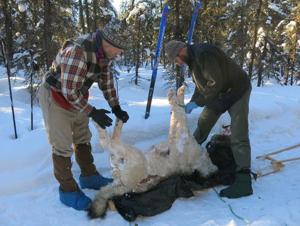FAIRBANKS
— On Presidents Day in 2014, a musher in the Chena State Recreation
Area stumbled on a wolf carcass in the middle of the Nugget Creek Trail.
Right in the middle, in fact. Her reluctant dog team had to run over
the carcass to pass it.
Ned
Rozell, a science writer at the University of Alaska Fairbanks
Geophysical Institute, heard about the wolf and headed to the site with
Tom Paragi and Mike Taras, biologists with the Alaska Department of Fish
and Game, and Cam Leonard to investigate what might have killed the
large, cream-colored female wolf, and why the carcass was left on a
well-used snowmachine trail.
Rozell
described the wolf in his Alaska Science Forum column: “Stretched out
on the snow as it was when the musher came upon it five days earlier,
the wolf has feet pads as large as a man’s hand. Its extended legs are
surprisingly long. The wolf has perfect toenails the size of an eagle’s
talons.”
Paragi’s
first instinct was that the wolf had been shot and killed. But if so,
why would the shooter not salvage the carcass? Even a wolf killed in
self-defense must be skinned and reported to the Department of Fish and
Game. Clues in the snow surrounding the carcass raised more questions.
Rozell
explored those questions in two columns published in late winter 2014.
He will talk about the mystery of what killed the South Fork wolf during
a lecture June 10 as part of the University of Alaska Summer Sessions
Discover Alaska series.
“This
might be my favorite two columns in 20-plus years of writing them,” he
wrote earlier this week. “I loved the combination of getting out with
good people in a place I know. Also that everyone, including the
biologists at first, assumed they knew what killed the wolf. But the
cause of death was not their first guess despite it being fairly common.
I especially liked all this drama unfolding a few miles off Chena Hot
Springs Road.”
Rozell
and his companions took the wolf carcass to wildlife veterinarian
Kimberlee Beckmen, who dissected the carcass and discovered the wounds
that led to the otherwise healthy, 5-year-old female’s death. Together
with Fish and Game biologist Mike Gardner, they laid out the fatal
scenario.
Gardner
said the death of the South Fork wolf is not unusual, Rozell wrote in
the second column. “This wolf lived longer than most. Evidence that
wolves bedded down for some time on a hillside less than 100 yards away
could suggest the South Fork wolf was one of the parent wolves of a
pack. Parent wolves are almost always the ones that kill large prey like
moose.
“‘She was an important wolf,’” Gardner said.
If You Go
What: Ned Rozell on The Mystery of the South Fork Wolf
When: 7 p.m. June 10
Where: Murie Building Auditorium on the UAF campus
Cost: Free





No comments:
Post a Comment